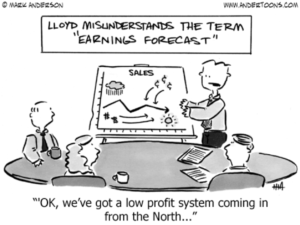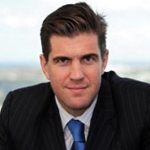Blog
Buy Hold Sell: The Dividend Dilemma – TCL, SYD, SGP
Behind the scenes in reporting season
Over the last two weeks and for the next fortnight, visitors to the Sydney CBD may have noticed stressed analysts and fund managers in sharp suits moving about with unusual velocity and with a slightly greater degree of self-importance than normal. Simultaneously, stories from financial journalists are migrating to the front page of the paper. The cause of these phenomena is the ASX-listed company profit reporting seasons, which occurs twice a year with the regular timing of the Serengeti wildebeest migration.

Reporting season is a stressful time, as it reveals how a company is performing in financial measures such as profit, margins, debt and free cash flow, as against the expectations in analysts’ models that are used to derive a valuation. When companies reveal unpleasant surprises or point to problems in the future, the company’s stock price can decline sharply. Alternatively, it can be very pleasant when the company reports a good result which validates the investment case for owning their shares. In this week’s piece, we are going to go through how Atlas approaches each day during reporting season and what happens during a typical day in the earnings reporting season.
Before the day
In mid-January and July (in advance of the August season), Atlas reviews the companies in the portfolio and looks at our expectations for key factors against both the company’s guidance and consensus analyst forecasts. The purpose of this exercise is not so much to identify companies performing ahead of expectations, but to find those in the portfolio that have the potential to cause losses on results day. Take for example Primary Health: the weak Medicare data coming through over the past few months combined with ongoing uncertainty over Government health policy would have alerted investors to the possibility that the company was facing tougher conditions that the market expected.
On results day all is revealed
Companies normally post their results with the ASX around 9am, which gives investors some time to digest the numbers and develop a view before the stock begins trading at 10am. During this period, we will be combing through the profit and loss, balance sheet and cash flow statements, comparing our forecasts to what the company delivered. Also, it is important to compare how a company has performed against their peer group. For example, Woolworths report their results next Wednesday (22 February) and the share price reaction will be strongly influenced by how the grocery business performed relative to Coles (+1.3% sales growth and 4.6% profit margin).
Company management will then formally present their results to shareholders on a conference call or at their offices during the morning, generally between 9:30am and midday. These presentations are directed towards the institutional investment community and are effectively closed to the media and public. They can take between thirty minutes and two hours, with the management having the opportunity to explain their results and discuss factors that will influence future profits. If the company has had a poorly received result and the stock price is falling, this will give management the opportunity to calm the market and clear up some uncertainties.
The most informative part – in our opinion – is always the questions section at the end as it gives investors the chance to see how confident management are in dealing with the issues that investors may have with the financial accounts after they have departed from the prepared scripts. Earlier this week, many investors observed that Australia’s largest office landlord Dexus Property struggled when explaining the amounts and accounting treatment of the cash used to break interest rate hedges. Whilst this sounds innocuous, listed property trusts exclude the payment for breaking these hedges from their current profits, yet highlight the earnings growth from lower interest costs in future years. In our view this is accounting smoke and mirrors!
Typically, it will only be the sell side analysts asking questions of management in the results presentation, with the large institutional investors saving their questions for their own individual meetings with management. However occasionally fund managers become frustrated when company management receive “soft” questions from the sell-side analysts after releasing a result that disappointed the markets. These soft questions can be the result of some sell side analysts wanting to protect their relationship with the company. The last time that I asked a question was a few years ago at a QBE Insurance result. The stock price was down 10% on the day due to some surprise provisions. Here I was frustrated by the analysts asking benign questions about future years’ depreciation charges, and this prompted me to inquire as to “What comparative advantage does QBE have in writing Argentinian workers compensation insurance?”.
Afterwards
In the week after the results, the company will organise one-hour meetings with their domestic and international institutional shareholders. In these meetings, it is important to be well prepared to maximise the value of the time that you get with management, as this is often a key factor when deciding whether to commit investors’ capital to the company. Whilst these meetings can be either quite hostile or very friendly, they are a valuable forum for both parties to give feedback on not only how our clients’ capital has been managed in the past, but also how that capital should be employed in the future.
In recent meetings, one of the key topics that I have discussed with management is their attitudes to debt and gearing. Currently investment grade companies can obtain debt at historically low prices and – more importantly – with long duration, which would suggest that companies should raise their gearing to boost returns. The counterpoint to the thesis of increasing borrowings is the lingering memories of the GFC. Accordingly, many companies are reluctant to pay high prices for existing assets or do not have sufficient confidence in the economic outlook or political stability to spend capital.
Trading – measured decisions not made in haste
Whilst the stock-broking community would clearly prefer that fund managers trade immediately and often based on company results, the decisions to make dramatic changes to a position for fundamentally-based fund managers will only occur after sober analysis of the company’s results. The fund manager will then examine what changes are made to valuations and look at the set of competing investment opportunities and their expected returns including cash. We believe that most of the trading volume on the day of a result is either due to short term momentum-based hedge funds, or most likely the machines behind algorithmic trading. This may explain moves such as we saw earlier this week with Treasury Wine, who after reporting was down -5% on Monday, but gained +4% on Tuesday.
Reporting season is like Christmas for investors, in that we get to have a close look at the companies in which we have entrusted our capital, examine the financials, and ask questions of the management teams running these companies. Additionally it can give us a greater insight than ABS statistics into what is actually happening in the economy.
Hugh Dive CFA
Chief Investment Officer
Interview with Chris Hall on Boardoom.media
Industry Moves: A new venture: Q&A with Hugh Dive of Atlas Funds Management
![]()

Hugh Dive has long-held a desire to run his own business and has recently taken the plunge to set up his own boutique investment firm. He tells Industry Moves about the two funds that are set to launch in 2017, shares what his wife feels is his greatest career achievement to date, and tells us about two industry veterans who have inspired him along the way.
- What lead you towards starting up your own business, Atlas Funds Management?
- I have been an equity analyst for close to twenty years and this role often involves sitting across the table from public company CEOs and CFOs, pulling apart financials and questioning them about decisions that they have made in running their business. Like many fund managers, I have always had a strong desire to run my own business, not only being in control of my own destiny, but also to be in control of how investors are treated. In my years in the funds management industry I have seen too much ordinary treatment of investors, which reflects poorly on the entire investment profession.
- Will others be joining you in your new venture?
- Yes, we will be adding team members in line with fund inflows.
- What are your main goals for the company over the next 12 months?
- The main goal over the next twelve months will be to place Atlas Funds Management on a firm footing and have two funds listed and performing well for investors.
- You have two new funds to be launched soon – are you able to tell us a little more about what you will be bringing to the market?
- Initially we will be launching the Atlas High Income Property Fund, in the first half of 2017. This will be a low volatility, quality-style income fund comprised of high quality listed property securities. Additionally, we seek to boost income by utilising an active strategy of selling call options over this portfolio of ASX-listed property securities. This effectively converts a portion of tomorrow’s uncertain gains into certain income today. This strategy is expected to allow us to pay distributions quarterly to investors and we will be seeking to deliver an annual yield of 8% paid quarterly in arrears. In the second half of the year we are targeting launching the Atlas High Income Equity Fund, a long/short fund designed to harvest additional franking credits for investors.
- You’ve had an interesting career, what do you feel has been your greatest achievement so far?
- My wife may say that it would be keeping a marriage going through an interesting career. In my career in funds management I have worked in both the Canadian and Australian markets and have helped manage funds at very large, medium size and small fund managers. Interspersed with this was a few years as a sell-side analyst covering basic materials at a large US investment bank, a memorable moment of which was when I was told that I was going to do a marketing trip to Europe for three days and two nights. I initially thought a trick was being played on me, sadly it was not.
- Who has had the biggest influence on your career so far?
- Two individuals have influenced my career, Phil Cotterill from CC&L in Canada and Anton Tagliaferro from Investors Mutual. They both have a passion for investing and in particular a fascination for pulling apart companies to understand what are the factors that will make some companies succeed and others fail. They have both instilled in me the need to view economic and political events in terms of their impact on your portfolio and attempt to identify long range factors that can impact a company’s business model.
- How do you maintain a work/life balance?
- I really enjoy cycling as being on the road early clears my head and puts me in a great frame of mind to tackle the daily gyrations of the ASX. I especially like riding with my cycling team WAM Velo, which is kindly supported by Geoff Wilson. I plan on beating Geoff in the upcoming Blayney to Bathurst race in April, after a cunning move in last year’s race resulted in the wily veteran finishing ahead of me.
See original post in Industry Moves https://industrymoves.com/q-and-a/q-a-with-hugh-dive-on-his-new-venture


